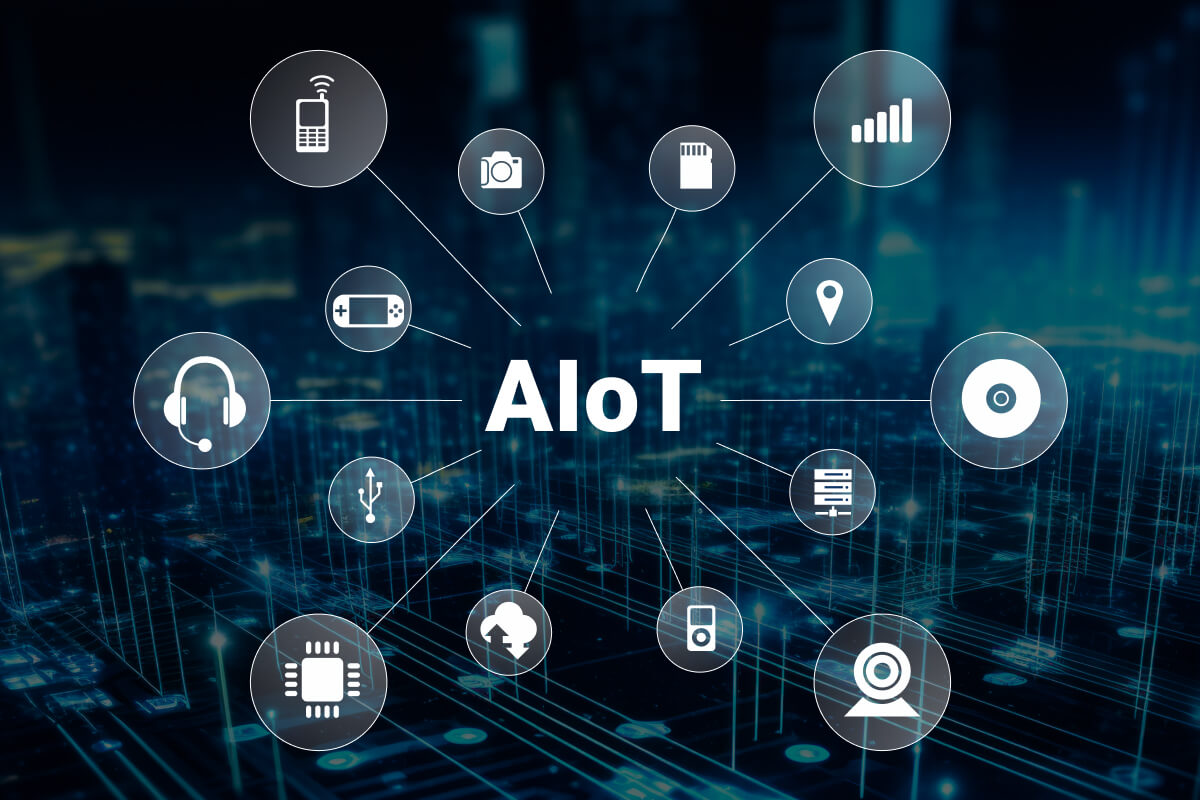IoT-based smart lighting solutions bring benefits not only to end users but also to businessmen and managers. The global smart lighting market is expected to nearly quadruple to $44 billion by 2030 from about $11 billion in 2020①. With the advent of smart lighting, the latest innovation in lighting, companies and governments are unleashing the power of the Internet of Things to reduce energy consumption and costs.
This article introduces the three categories of smart lighting and the benefits of smart lighting using IoT, especially for related equipment manufacturers and managers.
What is smart lighting using IoT?
Smart lighting employs IoT-enabled sensors, smart bulbs, or IoT gateways to enable users to control their home or workplace lighting through smartphone or home automation platform. Smart lighting solutions can be controlled by an external device such as a smartphone or smart assistant, scheduled, or triggered by sound or motion. According to their application and control method, the intelligent lighting system in the market is divided into three categories.
Smart bulb
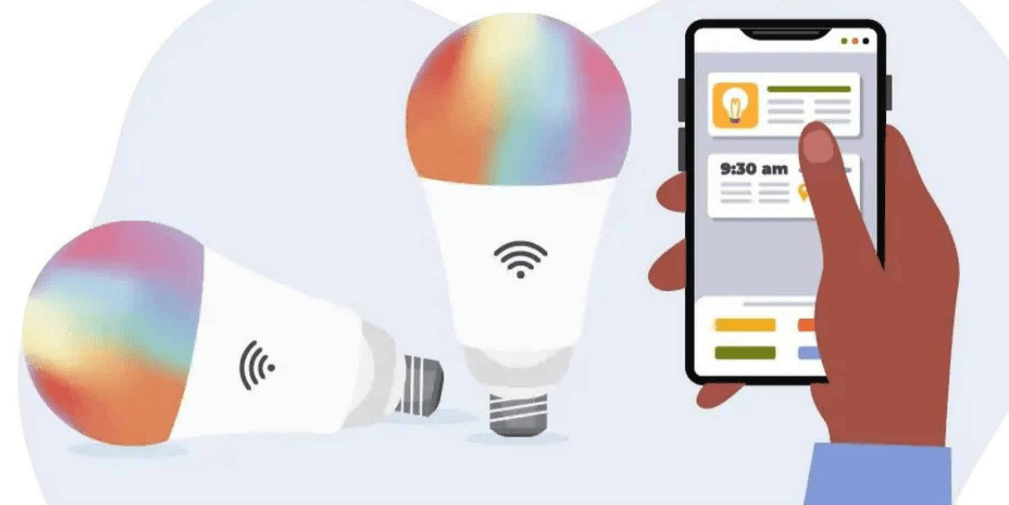
A smart bulb is an internet-connected LED light bulb that can be customised, scheduled, and controlled remotely. Smart bulbs are among the most popular devices in the burgeoning field of home automation and Internet of Things (IoT) goods.
Smart bulbs may be controlled by a mobile app or an IoT gateway with the integration of Wi-Fi, Bluetooth, ZigBee, or a custom connection for home automation systems, and individual bulbs can be programmed to alter output in a specified manner.
Because the bulb is internet-connected, suppliers may leverage edge computing to outfit smart bulbs with features such as built-in cameras, built-in speakers, and presence-sensing functionality. For the users, you can use phone to turn smart bulbs on and off remotely, adjust the colour of their lights, and plan their cycles.
If they link to other smart home gadgets, you’ll be able to design rules that turn on the lights depending on specific events, such as your door opening or a security sensor being activated.
Motion detection smart light
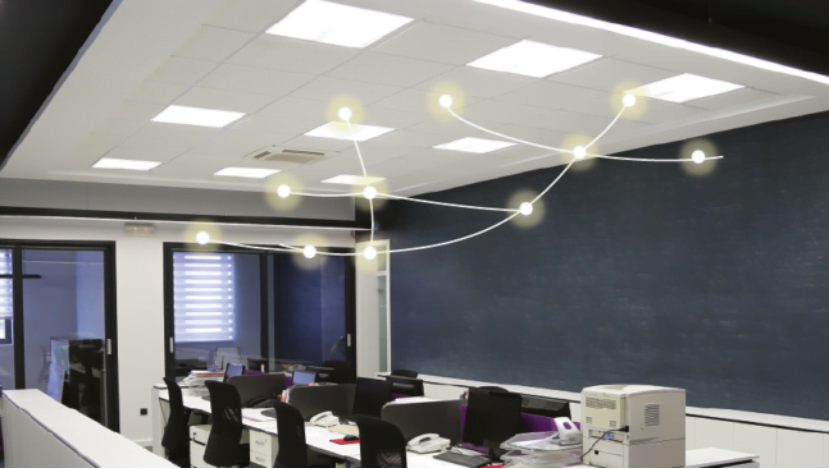
Motion-sensing smart lights detect and respond to motion by combining sensors, microprocessors, and wireless communication technologies. Typically, the sensors are passive infrared (PIR) sensors that detect heat signatures and movement within their range of vision.
When the PIR sensor detects movement, it sends a signal to the microcontroller, which analyses it and turns on the light. The light may switch on at a pre-set brightness level, or it may gradually ramp up from a lowered level, depending on the smart lighting system.
Some smart lights, in addition to motion detection, may contain other smart sensors, such as ambient light sensors, which detect the amount of natural light in the room and alter the light output appropriately. This improves energy efficiency and eliminates the need for needless illumination.
Smart lighting system connected to an IoT gateway
Commands transmitted from the cloud server will be forwarded to the sub-device network via smart home protocols, built-in apps, and IoT gateways; the status of the sub-device can also be relayed to the server via the IoT gateway. As a result, you can easily operate the IoT smart lighting system from your laptop or mobile phone at any time and from any location.
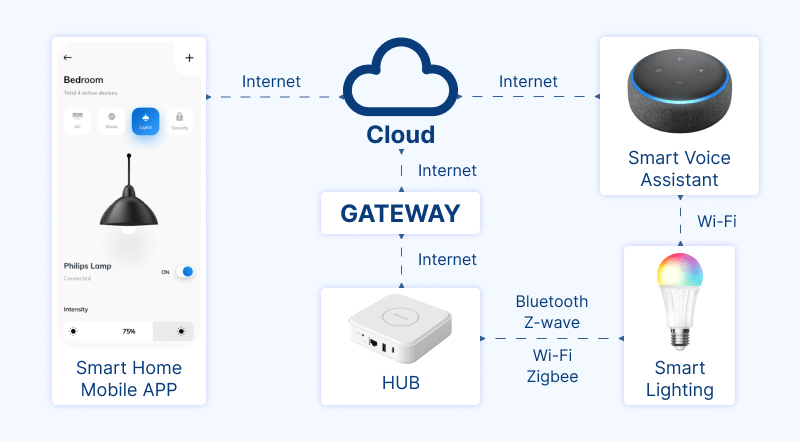
IoT features for smart lighting
Indoor positioning systems based on lighting: IoT smart lighting may be utilized for indoor positioning, tracking people and assets in real-time. The smart lighting system can reliably pinpoint the position of a person or item in a building using sensors and Wi-Fi networks , which may be beneficial for navigation, security, and asset management. IoT smart lighting can assist minimize energy use by automatically altering lighting settings and shutting off lights when no one is in the room.
Asset tracking
Smart lighting systems using IoT can be used to track assets, including various equipment in commercial and industrial scenarios, which helps optimize inventory management and reduce the risk of equipment loss.
Perishable product condition monitoring
IoT smart lighting can also be used to monitor the condition of perishable goods such as food and pharmaceuticals. The system can assess temperature, humidity and other environmental conditions that can affect the quality of items by placing sensors in lighting fixtures. This helps prevent spoilage, reduces waste and maintains product quality.
Optimize space utilization
Smart lighting systems can also be used to maximize space in buildings such as workplaces and public areas. The technology may alter lighting settings and propose adjustments to the structure of the room to increase efficiency and productivity by studying occupancy patterns and use statistics. This can assist to cut expenses while also increasing consumer pleasure.
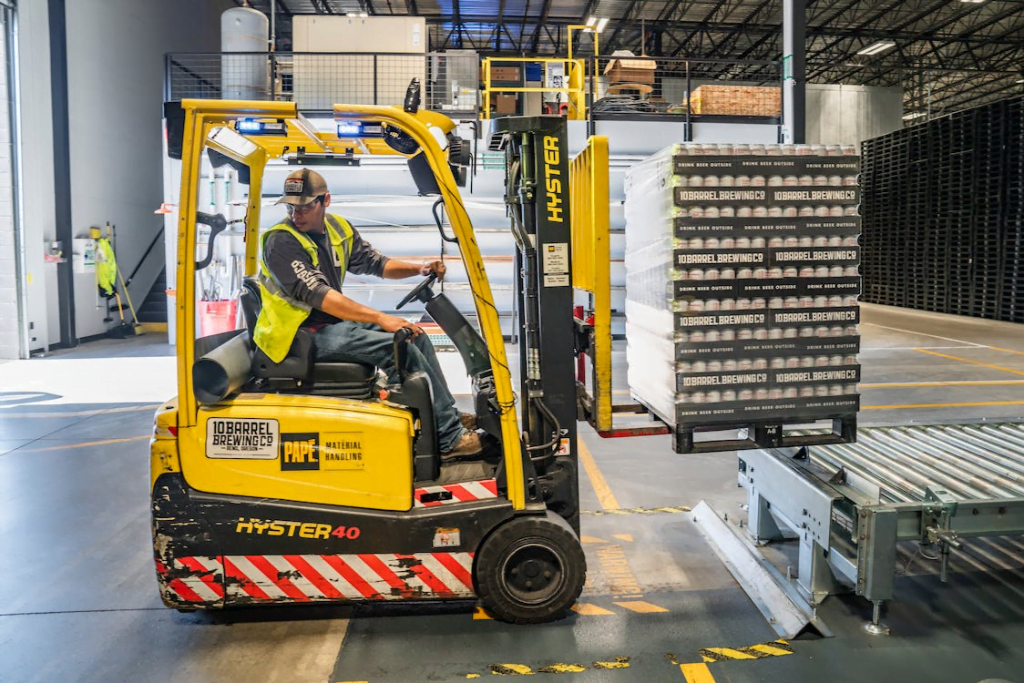
Smart City
Smart cities can’t function without Internet of Things (IoT) smart lighting. By utilizing sensors and automated systems to regulate lighting based on occupancy, time of day, and other criteria, cities are able to save energy and money. Smart lighting also has the added benefit of enhancing security by automatically recognizing and reacting to abnormal occurrences like accidents or crises.
But there’s more to smart cities than just fancy lights. Smart transportation, waste management, public safety, healthcare, and many other interconnected systems and services are all part of it. Together, these solutions will help the city run more efficiently, raise residents’ standard of living, and lessen its environmental impact.
It is frequently situated overhead, which is a practical location to give full coverage, thanks to the smart lighting design. Smart lighting won’t compromise the space’s aesthetics or functioning and won’t necessitate a new architectural design in order to improve the lighting infrastructure of a city, industrial park, or store.
Benefits of smart lighting
The advantages of smart lighting solution for inhabitants, such as ease and customisation, are frequently mentioned. In addition to those end-users, equipment manufacturers and estate managers may reap the benefits of smart lighting technology.
Reduced manufacturing costs
Smart lighting systems can be made more efficient by using fewer materials and components. Smart LED lighting systems, for example, use fewer bulbs and fixtures than traditional lighting systems, lowering the quantity of material needed for manufacture. Furthermore, smart lighting systems may be engineered to utilise less electricity, lowering manufacturing costs and resulting in more energy-efficient goods.
Enhanced product features
Smart lighting may be included into equipment manufacturers’ goods to bring new features and capabilities that help differentiate their products in the market and boost their value proposition. Smart lighting systems, for example, may be built to be controlled by voice commands or mobile apps, providing consumers with a new level of convenience and usefulness.
Increased energy efficiency
Increased energy efficiency is one of the key advantages of smart lighting. Managers can monitor and regulate lighting consumption throughout their facilities using smart lighting, allowing them to optimise energy usage and minimise expenditures. They can, for example, set up automatic schedules that turn off lights when they are not needed or vary the brightness of lights based on the quantity of natural light in the space. The IoT smart lighting system aids in lowering energy use and power costs, which can have a substantial influence on the bottom line.
Decision optimization
Smart lighting solutions may also give important data based on IoT technology about energy usage, lighting patterns, and occupancy levels, allowing managers to make educated facility management and maintenance choices. People can use data gathered from the IoT gateway to detect underutilised or overutilized regions of their facilities and alter lighting accordingly. This can aid in optimising facility utilisation and lowering expenditures.
How IoT gateway works with smart Lighting?
When utilized with smart lighting, an IoT gateway acts as a hub to connect and manage the smart lighting devices. This is how it goes:
Communication protocols
The smart lighting devices and IoT gateway must be able to communicate with one another. Typically, a wireless technology like Zigbee, Z-Wave, or Bluetooth is used for this.
Data transmission
The IoT gateway will receive data from the smart lighting devices, including the device’s current state (on/off), brightness level, and any other information it can handle. The communication protocol is used to send this data.
Processing at the gateway
Following receipt of data from the smart lighting devices, the IoT gateway processes that data. This could be keeping the data for later use, looking through it to find trends, or acting on the information received.
Control and automation
Control and automation of the lighting devices are two of the main advantages of using an IoT gateway with smart lighting. The IoT gateway may transmit instructions to the smart lighting systems to switch them on or off, change the brightness, or program them to turn on or off at certain intervals.
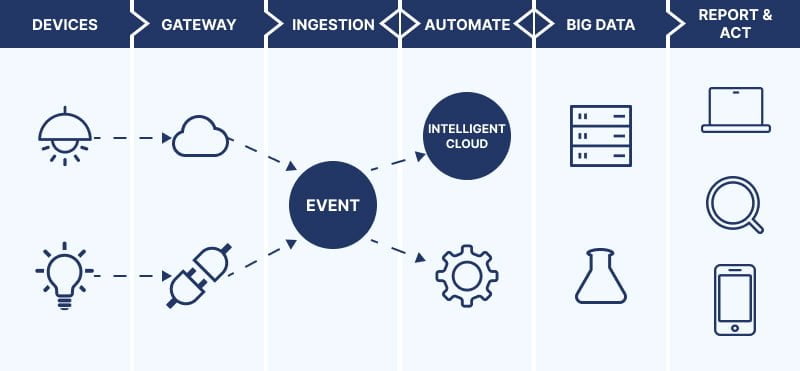
Communication interfaces for smart lighting
IoT smart lighting can choose a variety of communication protocols according to the needs of specific scenarios.
Zigbee
Zigbee is often used for smart lighting, as it allows for reliable communication and efficient power usage. General industrial facilities’ interior lighting systems are classified as follows: general lighting, partition lighting, local lighting, and mixed lighting. Different lighting systems have distinct needs as well, like changing the brightness of the interior lights, controlling lights by divisions and groups, monitoring the state of lighting in real time, etc., which requires each light to be able to communicate in a network.
Appropriate lighting may increase job efficiency, decrease mistake rates, and save energy. This places significant demands on getting real-time information from industrial lighting fixtures in a timely manner, as well as implementing centralized and unified administration.
Traditional lighting often communicate via cable communication. Although wired communication is dependable and has great anti-interference capabilities, it also has the disadvantage of hefty wiring expenses. Wireless Zigbee technology can serve as a simple, quick and stable network method.
Each lighting controller may be equipped with a Zigbee module and form a network to communicate with a Zigbee gateway. Simultaneously, Zigbee gateway may immediately transform Zigbee signal into Ethernet//WiFi/LTE 4G information. In this way, the status of the lights in real time is uploaded to the server. And the server may send control commands to alter and control each lighting fixture in groups and partitions.
LoRaWAN
Smart IoT lighting using LoRaWAN technology is more responsive, steady in performance, durable, economical, and competitive than using other traditional short-range radio frequency technologies (BLE, Zigbee, etc.). LoRaWAN is a popular long-distance, low-power wireless network technology that can operate globally in free frequency bands, and it does require the building of base stations. A single LoRaWAN gateways may handle multiple devices with flexible networking approaches, which drastically reduces construction costs.
The design of the LoRaWAN-based street lighting system is fairly simple, consisting of four main components: terminal nodes, gateways, network servers, and application servers, with application data being transferred in both directions. The specific working principle is as follows:
Each street light is embedded with LoRaWAN controller to control operations and links street lights to the LoRaWAN gateway. LoRa module installed in the LoRaWAN gateway communicates with light controllers and completes the data collection. After that, it will establishes a TCP connection with the LoRaWAN server via the 4G/WiFi module or Ethernet port. The timing policy issued by the LoRaWAN street lamp application server can be stored locally, and query commands will be responded. On the other hand, LoRaWAN gateway with embedded network server can intelligently regulate the light on and off based on the light sensor’s gathered value.
Remote application server can can work as data center for administration and analysis, and for users to operate and query using browsers.
Z-Wave
Z-Wave is similar to Zigbee in many ways but has a shorter range and lower power consumption. Z-Wave is often used in residential settings, as it is easy to set up and supports a wide range of devices.
You may be also interested in Zigbee Vs Z-Wave: Which is Better for Home Automation
Bluetooth
Bluetooth is used for IoT smart lighting, particularly in smaller networks or in settings where the range is not a concern. Bluetooth is easy to set up and widely supported but has a shorter range than Zigbee or Z-Wave.
BLE (Bluetooth Low Energy) can be a good choice for IoT smart lighting applications due to its low power consumption, small size, and compatibility. BLE also supports mesh networking, which enables multiple devices to communicate with each other and extend the range of the network without requiring additional infrastructure.
You may be also interested in How Can Bluetooth Gateway Help Smart Lighting System?
Wi-Fi
Wi-Fi can be used for IoT smart lighting, particularly in settings where a large number of devices need to be connected to the network. Wi-Fi has a relatively long range and high bandwidth, but can be more power- hungry than other protocols.
SoC technology in lighting
The use of smart lighting technology has grown in popularity in recent years due to its numerous advantages, including increased convenience, energy efficiency, and quality of life. Smart lighting equipment must, however, be able to successfully connect with other smart home gadgets, including smartphones, voice assistants, and other devices, in order to fully enjoy these advantages. Multi-protocol SOC can help in this situation.
Flexibility
A single chip known as a multi-protocol SOC is capable of supporting a variety of wireless communication protocols, including Bluetooth, Zigbee, Wi-Fi, and Thread. Regardless of the communication protocol they are employing, this gives smart lighting products the ability to interact with a larger range of other devices. For instance, a smart light might be operated by a voice assistant over Wi-Fi or through a Bluetooth IoT gateway with a multi-protocol SOC using a smartphone app.
Interoperability
Another significant benefit of adopting multi-protocol SOC in smart lighting products is interoperability. It can be challenging to include smart lighting devices into a single network due to the wide variety of communication protocols in use. However, multi-protocol may ensure that various devices can connect with one another in an effortless manner by supporting several protocols. For the development of a unified and integrated smart home ecosystem, interoperability is essential.
Safety
Security issues in the smart lighting industry might have severe repercussions. SoCs must be able to handle complex encryption and authentication processes in order to fulfill the demanding needs of smart lighting. Modern and efficient encryption methods may be processed by powerful processors in the newest generation of chips, preventing illegal access and safeguarding user data. SoCs typically come with specialized hardware security modules to facilitate encryption techniques more effectively.
Improved efficiency
Software stacks with more functionalities may be handled by chips with higher processing power and memory resources. This immediately leads to increased functionality being supported by smart lighting devices. Such characteristics may, for instance, support for battery operation, real-time synchronization systems, time schedulers for automatic control of LED luminaires, etc.
Cost-effective
A single multi-protocol SOC can fulfill all requirements instead of requiring numerous chips to handle various communication protocols. By making the smart lighting gadget more accessible and cheap for customers, this can lower its overall cost.
Choosing an IoT gateway embedded with a high-performance SOC can help realize IoT smart lighting more efficiently. SOCs with chips such as RK3328 and RK3308 can be suitable choices.
The Bluetooth Gateway and various end BLE Mesh devices are two essential components of the bluetooth mesh gateway solution. The most popular choice for an IoT-based BLE mesh network is the DSGW-210 BLE gateway. The DSGW-210 gateway hardware can do edge computing tasks as well as BLE Mesh protocols. It offers dependable connectivity for a variety of wireless Internet of Things devices.
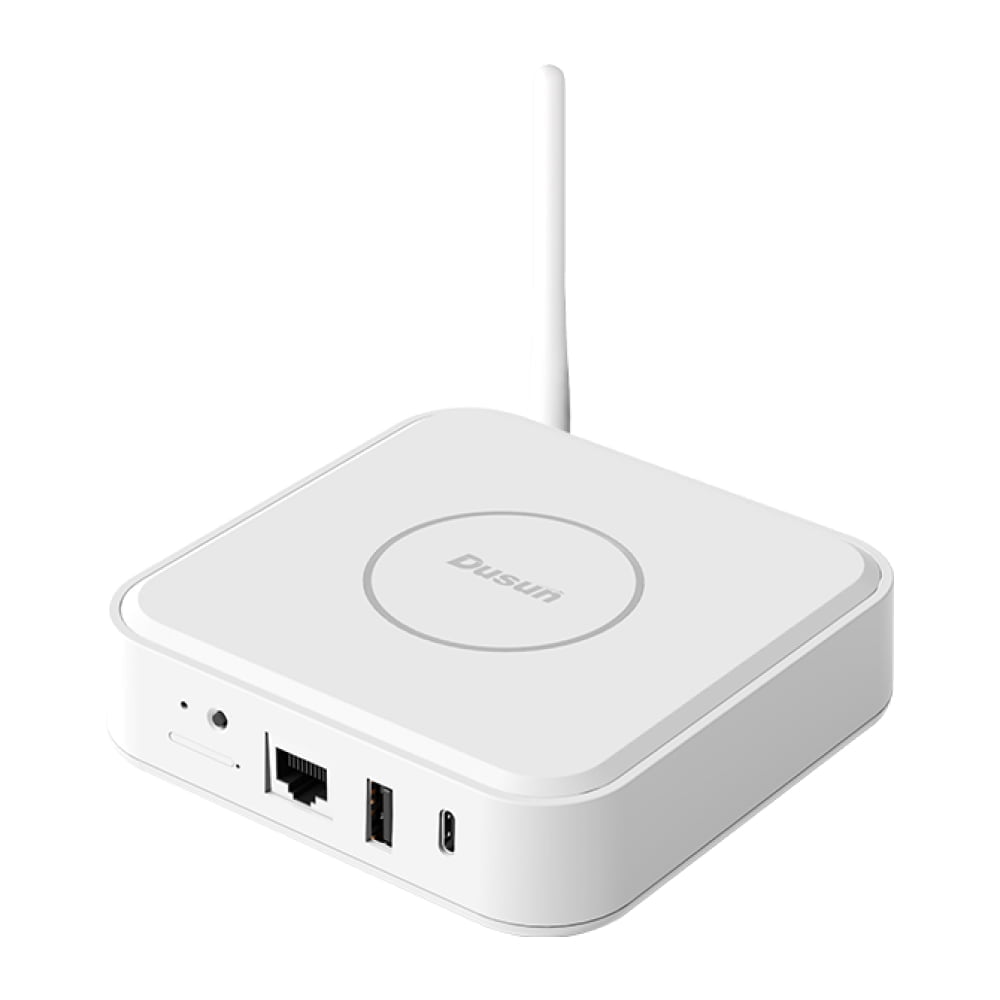
The gateway’s modular architecture enables users to add or remove any connector they like or are not required to, allowing for maximum feature customisation. Additionally, it is a ready-made solution to which you may easily port your application.
Dusun IoT offers a full range of lighting components, such as drivers, smart switches and smart sensors. With our IoT gateway, you may create simple to complicated IoT lighting control solutions and choose the desired features to meet the needs of your customers. We also offer firmware-enabled modules for lighting component manufacturers to swiftly connect to wireless lighting solutions.
Smart lighting solutions can be applied in many fields including industrial and commercial lighting, home lighting, outdoor lighting and public lighting. Its applicable places involve factories, families, schools, exhibition halls, stations, airports and hospitals, etc. Dusun IoT is deeply involved in the IoT smart lighting industry, providing efficient and cost-effective smart lighting solutions for countless companies.
You may also be interested in IoT Based Greenhouse Monitoring and Control System for Smart Agriculture to see how smart lighting can help factories
Please do not hesitate to fill out the side form to contact Dusun IoT, our engineers will tailor a smart lighting solution for your IoT project.
Smart lighting FAQs
When turned off, do smart lights utilise electricity?
Yes. Even when they are switched off or in standby mode, they consume electricity. The lightbulb still requires a Bluetooth or internet connection in order to be turned on using a smartphone or other smart device.
Are products for smart lighting expensive?
Yes. Even when they are switched off or in standby mode, they consume electricity. The lightbulb still requires a Bluetooth or internet connection in order to be turned on using a smartphone or other smart device.
Are products for smart lighting expensive?
Depending on the type of product and the functions it delivers, the cost of smart lighting products can vary. The long-term energy savings and enhanced functionality, however, can make smart lighting goods a reasonable investment. Many smart lighting products are priced competitively with traditional lighting products.
Can I employ smart lighting items without a smart home system?
No, a lot of smart lighting solutions can be utilised independently and without a smart home system. The addition of voice control and automatic scheduling, among other features, may be provided by combining your smart lighting items with a smart home system.
Can devices for smart lighting be utilised in commercial structures?
As they provide many of the same advantages as smart lighting solutions for homes, such as increased energy efficiency and better control over lighting levels, smart lighting devices are indeed growing in popularity in business buildings.
How does IoT lighting work?
IoT smart lighting employs wireless switches, which eliminates the need to wire light switches directly to fixtures. These bulbs are then linked to a network, allowing them to be monitored and controlled from the cloud.
Is a smart bulb an Internet of Things device?
A smart bulb is an internet-connected LED light bulb that can be customized, scheduled, and controlled remotely. Smart bulbs are among the most popular products in the growing category of home automation and Internet of Things (IoT) products.
Reference
Thormundsson, B. (2022) Global smart lighting market revenue 2020-2030, Statista. Available at: https://www.statista.com/statistics/813066/world-smart-lighting-market-revenue/













